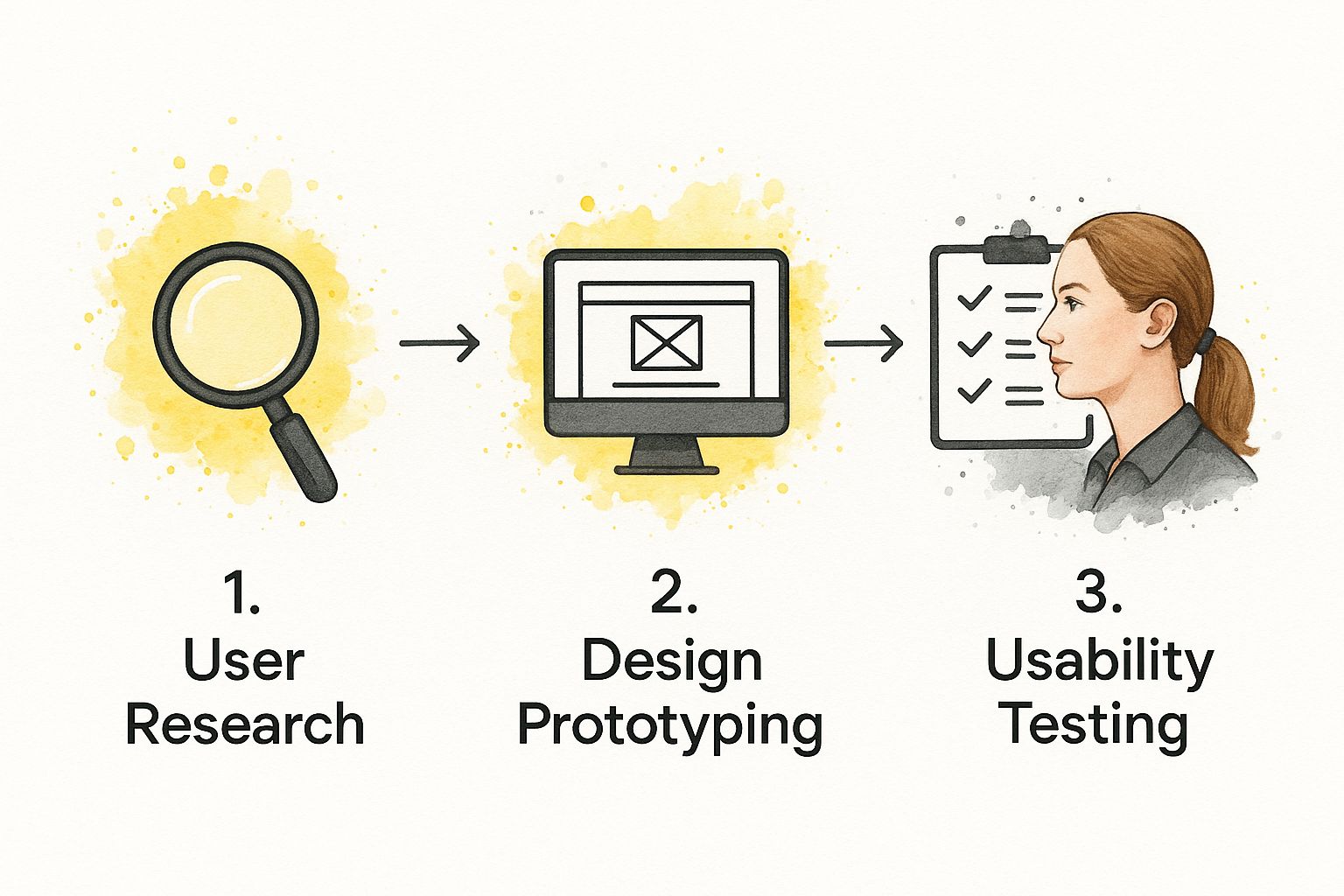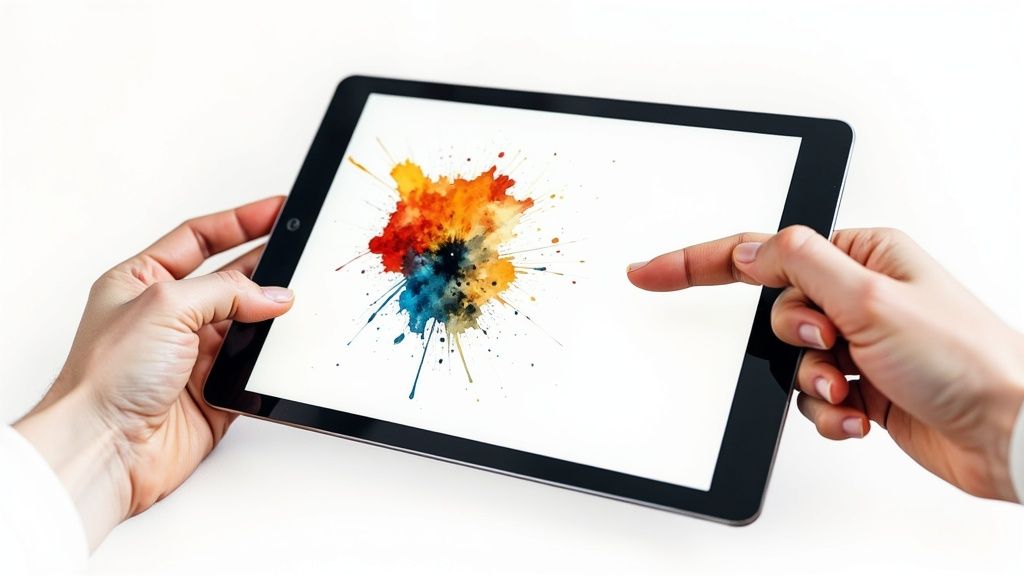A Guide to User Centered Design Principles
User-centered design principles aren't just a set of rules; they're a philosophy. At its heart, this approach is about putting the real-world needs, wants, and limitations of your users at the absolute center of everything you do, from the first spark of an idea to the final product launch. It’s a commitment to empathy, constantly seeking feedback to create products that feel less like tools and more like intuitive extensions of the user.
Why Putting the User First is Non-Negotiable
Thinking "user-first" isn't just a nice-to-have or a passing trend—it's the foundation of any digital product that hopes to succeed.
Imagine you're an architect designing a custom home. You wouldn't just start pouring concrete without deeply understanding the family who will live there. You'd want to know their daily routines, their hobbies, how they entertain guests. In the same way, user-centered design principles stop you from guessing what people need. Instead, you build solutions based on real evidence of their actual goals and pain points.
This entire mindset is built on a continuous feedback loop, ensuring the final product genuinely connects with the people it's designed for.
At its core, user-centered design is an iterative process. It's a structured approach where you consistently check back with your users to ensure the design is on the right track, preventing costly mistakes and wasted effort down the line.
From the initial concept to the final code, the user’s voice is the guide for every single decision.
The Core Phases of User-Centered Design
The user-centered design process isn't a straight line you follow from A to B. It's a dynamic, cyclical framework that ensures you're always moving in the right direction. It keeps the user involved at every critical juncture.
This table breaks down the four essential phases that make up this iterative loop. Notice how the output of one phase becomes the crucial input for the next, creating a cycle of continuous learning and refinement.
| Phase | Objective | Key Activities |
|---|---|---|
| Understand | Gain a deep, empathetic understanding of the user, their environment, and their goals. | Contextual interviews, user observation, surveys, competitor analysis. |
| Specify | Translate research insights into clear, actionable requirements for the design. | Creating user personas, defining user stories, mapping customer journeys. |
| Design | Develop potential solutions that address the specified user requirements. | Sketching, wireframing, building low and high-fidelity prototypes. |
| Evaluate | Test the proposed designs with real users to gather feedback and identify areas for improvement. | Usability testing, A/B testing, collecting user feedback, analyzing metrics. |
By moving through these phases—often multiple times—you methodically reduce assumptions and increase the likelihood that your final design will be a genuine success.
The journey looks something like this:

This constant cycle of research, design, and testing is what makes the final product so effective. It’s not about getting it perfect the first time; it’s about refining it until it perfectly serves the user.
The Breakthroughs That Put Users First

To really get why user-centered design is so important, it helps to look back at where it came from. The ideas we treat as standard today weren’t just dreamed up overnight; they were born from a massive shift in how people thought about technology. For a long time, tech was built by engineers, for engineers. The result? Products that were powerful, sure, but often required a degree in computer science to use, shutting out almost everyone else.
This "engineering-first" mindset started to crack in the 1970s. A few forward-thinkers began to realize that a machine's power is worthless if no one can figure out how to use it. The focus slowly began to shift from what a machine could do to what a person could do with it. This was the spark that ignited the user-centered design movement.
The PARC Revolution
One of the most important moments in this story happened at a place called Xerox's Palo Alto Research Center (PARC). Researchers there were given a simple but huge task: imagine the future of the office. Instead of just trying to build faster machines, they zeroed in on making computers intuitive for people who weren't engineers.
The core idea was radical for its time. Technology should adapt to human behavior, not the other way around. This insight laid the groundwork for modern computing as we know it.
This change in perspective led to some of the most fundamental inventions we now take for granted. The team at PARC was responsible for developing:
- The Graphical User Interface (GUI): This was a game-changer. It threw out the intimidating command-line prompts and replaced them with visual icons, windows, and menus. Suddenly, computers made sense visually.
- The Computer Mouse: To navigate this new visual world, they needed a new tool. The mouse was created to let people physically point, click, and drag things on the screen, making interaction direct and intuitive.
- Object-Oriented Programming: Even the way software was built changed. This new programming style was designed to mirror how people think about real-world objects, making it easier to manage and build complex systems.
These user-first ideas caught fire just as personal computers started to emerge. While early machines like the Altair were for die-hard hobbyists, it was Apple’s 1984 launch of the Macintosh that brought user-centered design to the mainstream. The Mac was the first smash-hit personal computer to ship with a GUI and a mouse, proving that an easy-to-use product could have enormous commercial appeal. It was a clear turning point. You can explore more about this fascinating history of UX design and its impact.
UCD's Lasting Impact
The wild success of the Macintosh proved that designing for people, not just for specs, opened up technology to a massive new audience. It showed that user-centered design principles weren't just some academic theory—they were a powerful business strategy. This history proves that putting the user first isn't a trend; it's a time-tested approach that's more critical today than ever before.
How to Truly Understand Your User's World

Great design always starts with empathy. This isn't just a buzzword; it's the core principle of user-centered design. It’s about genuinely getting to know your users—their real-world challenges, their daily routines, and the unspoken needs that drive their behavior. To do this, you have to consciously step outside of your own bubble and see the world through their eyes.
Think of it like being a detective. You wouldn't solve a crime by sitting in your office and making assumptions. You'd go to the scene, talk to witnesses, and hunt for the small clues everyone else overlooked. In the same way, you can't design something that truly helps people by relying on guesswork or generic demographics.
This is all about digging for the "why" behind what people do. Why does a specific task make them frustrated? What clever workarounds have they invented to get by? Answering these questions is the first step toward creating something that people will actually value and use.
Going Beyond the Obvious
The most powerful insights rarely come from a survey or a focus group. They come from watching people in their natural element. This is where methods like contextual inquiries and ethnographic studies shine. Seeing someone try to use a product at their cluttered desk or on a bumpy bus ride will reveal pain points they would never think to tell you about.
To get a real handle on your users' needs and habits, you have to use the right research strategies. You can explore a range of essential user research methods to find the ones that will gather the most meaningful information for your specific project.
The goal isn’t just to collect data; it's to build empathy. When you understand a user's world, you move from designing for them to designing with them in mind.
This deep understanding is your best defense against building features that nobody asked for. It grounds your work in reality and ensures you’re solving real, documented problems.
Transforming Observations into Actionable Tools
So you've done your research, but now you're swimming in raw notes, recordings, and observations. The next crucial step is to organize all that information into practical tools that your whole team can understand and use. This is how you turn empathy into a shared roadmap for making decisions.
Two of the most indispensable tools for this are:
- User Personas: These aren't just vague demographic profiles. A good persona is a rich, fictional character built from your real research data. It details their goals, motivations, frustrations, and even a bit of their backstory. Personas make your users feel real, helping your team ask, "What would our persona, Sarah, do in this situation?"
- User Journey Maps: This tool visualizes the complete experience a person has with your product or service. It maps out every single step, from the moment they first hear about you to the point where they achieve their goal. By charting their thoughts, feelings, and pain points along the way, you can pinpoint exactly where the experience breaks down and find opportunities to make it better.
Using tools like these keeps the user at the heart of every conversation and decision.
Inclusive Research for Broader Impact
A critical piece of understanding your user's world is making sure your research is inclusive. This means you must actively recruit and listen to people with diverse abilities, backgrounds, and perspectives. If you only test your product with a narrow, homogenous group, you're almost guaranteed to create something that excludes huge segments of your potential audience.
Thinking about accessibility from day one is fundamental to user-centered design. When you include people with disabilities in your research, you uncover usability issues that, when fixed, often improve the experience for everyone. For example, high-contrast text created for someone with low vision is also a lifesaver for anyone trying to use their phone in bright sunlight.
This inclusive mindset doesn't just make your product more ethical; it makes it objectively better and more robust. To learn more, our guide on how to make a website accessible provides actionable steps. Ultimately, this principle ensures you’re building for all your users, not just an imaginary "average" one.
Designing for Clarity and Simplicity
The best designs are often the ones you don't even notice. They just work. You’re guided from one step to the next without ever having to stop and think, "What am I supposed to do here?" This is the essence of designing for clarity and simplicity, a cornerstone of user-centered design. When an interface is clear, it feels effortless.
I like to think of it like great road signage on a highway. The best signs use clear symbols, easy-to-read text, and logical placement to get you to your exit without any confusion. A bad sign, on the other hand, can make you miss your turn and leave you completely frustrated. Your product's interface should be like that perfect set of signs—instantly understandable and totally reliable.
At its core, this principle is all about reducing cognitive load, which is just a technical way of saying "the amount of brainpower someone has to use." When people are hit with too many choices, weird layouts, or confusing jargon, they get tired fast. And when they get tired, they leave. A simple, clear design respects their mental energy.
Creating Intuitive Interfaces
So how do you achieve that level of clarity? It comes down to a few key ideas that, when combined, create an experience that feels completely natural. When you get these right, your product starts to feel less like a tool and more like an extension of the user's own thoughts.
Three ingredients are essential for a clear design:
- Visual Hierarchy: This is simply about arranging things to show what’s most important. You can use size, color, and placement to pull the user's eye toward the main action, like making the "Buy Now" button the most prominent thing on the page.
- Consistency: A consistent design is a predictable one. If your buttons, icons, and menus look and act the same way on every screen, people don't have to keep re-learning the rules. This builds trust and helps them move faster.
- Familiarity: Why reinvent the wheel? Using patterns that people already understand is a huge shortcut. Think of universal icons, like a magnifying glass for "search" or a shopping cart for an e-commerce store. They eliminate the learning curve entirely.
When you reduce cognitive load, you’re not "dumbing down" the design. You’re making it smarter and more efficient. The goal is to clear away the friction so people can focus on what they came to do, not on figuring out how your interface works.
Clarity and Simplicity in Practice
You can see this principle in action everywhere, from the minimalist homepages of major tech companies to the clean menus in your favorite mobile app. These designs aren't simple by accident; they are the result of stripping away anything that doesn't directly help the user. A solid navigation structure is a perfect example of this. If you're looking for inspiration, these website navigation examples really nail the art of simplicity.
For anyone using Linkero, applying this is very direct. As you build your page, ask yourself: what is the number one thing I want visitors to do? Make that your focus. Use a bigger font or a bolder color for your main call-to-action. Keep your link titles short, sweet, and to the point.
By creating a clear visual path and sticking to familiar layouts, you make it easy for your audience to connect with your content, which ultimately leads to a much better experience for them.
5. Your First Design Is Never Your Last

Here's a tough but essential truth every great designer eventually learns: your first idea is just a starting point. It’s never the final product. Truly exceptional design isn’t a lightning strike of genius; it’s a discovery made through a relentless cycle of testing, learning, and refining. Committing to this iterative process is what separates the products we tolerate from the ones we can't live without.
Think of it like being a sculptor. You don’t just walk up to a block of marble and reveal a masterpiece in one go. You start with a rough, unrefined shape. Your initial prototypes are just that—the first big cuts. It's the continuous process of chipping away, guided by what you see and feel, that slowly uncovers the elegant figure hidden inside.
This mindset is liberating. It removes the immense pressure to get everything perfect right out of the gate. Instead, it pushes you to get your ideas in front of real people as quickly as possible. Every bit of user feedback, every confused click, is another clue pointing you toward a better solution.
Turning Feedback into Momentum
At the heart of this principle is usability testing. Forget the image of a sterile lab with two-way mirrors; this should be a frequent, almost casual, activity. You don't need a massive budget to get valuable insights. One of the most effective methods is the simple "hallway test"—just grab a colleague or a friend and ask them to try your design for five minutes.
Your goal is to be a quiet observer. Watch where they get stuck, listen to what they say, and notice what makes them smile. These observations are pure gold because they replace your team's assumptions with cold, hard evidence, showing you exactly where to focus your efforts.
And this isn't just a feel-good exercise. The data shows it works. Designs that are continuously improved with user feedback consistently outperform those built on assumptions. One study found that interfaces optimized through user-centered design saw task completion rates jump by up to 25%. At the same time, user errors fell by over 15%, and learnability—how quickly someone can master the interface—improved by a solid 20%.
From Insight to Improvement
Once you’ve gathered feedback, the real work begins: turning those observations into tangible design improvements. You'll need to sort through the notes, prioritize the biggest pain points, and brainstorm solutions for the next version of your design.
The iterative loop—build, test, learn, repeat—is the engine of user-centered design. It ensures your product evolves based on real user behavior, not internal guesswork.
Just like in writing, the first draft is never the final word. The process of revision is where the magic happens. Exploring effective revision strategies for writers can offer surprising parallels for designers looking to polish their initial concepts into brilliant final products.
For Linkero users, putting this into practice is straightforward. You can create a new page in minutes.
- Build a quick version of your page.
- Share the link with a few people who match your target audience.
- Ask them simple questions: Is the main button obvious? Can you find what you need on your phone? Do you get what this page is about in five seconds?
Use their answers to make small, informed tweaks. Publish the changes, and don't be afraid to do it all over again. This simple feedback loop is how you transform a good Linkero page into an incredibly effective one.
Putting User-Centered Design Into Practice
https://www.youtube.com/embed/xuq4mTh50p4
Alright, let's move from theory to action. This is where the rubber meets the road and where user-centered design principles really start to shine. It’s time to connect the dots between understanding your user, designing with absolute clarity, and committing to constant improvement. Think of these not as separate steps on a checklist, but as interlocking gears in a single, powerful machine.
Integrating this approach really comes down to a shift in perspective. Instead of seeing design as just one phase of a project, you start to treat it as a core part of your culture that touches the entire development lifecycle. Every meeting, every decision, and every line of code should be guided by one simple question: "How does this actually help the user?"
Unifying the Core Principles
Truly great user-centered design happens when all the ideas we've covered start working together. It’s a beautiful synthesis: you gain a deep understanding of your user's world, which informs a design built for simplicity, which is then constantly refined through real feedback. When these principles fire on all cylinders, they create a cycle of improvement that’s tough to beat.
This holistic approach moves you from a world of guesswork and assumptions to one of informed decisions backed by real human behavior. That user-first mindset is what separates products that merely function from those that people genuinely love and tell their friends about.
The ultimate goal of user-centered design is to create an experience so seamless and intuitive that the user feels understood, empowered, and respected. This is the foundation of long-term customer loyalty.
Embracing this philosophy isn't just a nice-to-have; it's a direct investment in your product's future success. It’s hands-down the most reliable way to build something that not only meets a need but also forges a lasting, positive connection with your audience.
A Mindset for Lasting Success
Adopting user-centered design is more than just tweaking your workflow—it’s a strategic business decision. Products built with a deep understanding of their audience are far more likely to win in the market and inspire fierce loyalty. This approach slashes the risk of building features nobody wants, which saves you an incredible amount of time and money.
For any creator or entrepreneur, this is a massive advantage. Building a strong bond with your audience is fundamental, and this applies to your online presence just as much as it does to a physical product. For more on this, check out our guide on essential small business branding tips for practical advice on building that connection.
For Linkero users, this means always thinking about your visitor's journey:
- Understand Context: Who is clicking your link, and what are they hoping to find? A follower from Instagram? A potential client from LinkedIn?
- Design for Clarity: Is your most important call-to-action immediately obvious? Can someone find it in three seconds or less?
- Iterate with Feedback: Don't be shy! Ask a few friends to look at your page. Watch them use it. Can they easily get where they need to go?
By weaving these principles into how you work, you’re doing more than just building pages. You're creating experiences that win over your audience and drive the results you're after.
Answering Your Top Questions About User-Centered Design
As you start weaving these user-first ideas into your work, a few questions naturally come up. Getting clear on these points will help you confidently put these powerful concepts into practice. Let's tackle some of the most common ones.
What’s the Real Difference Between UCD and Human-Centered Design?
You’ll often hear these terms used interchangeably, but there's a small yet meaningful difference between them. Think of Human-Centered Design (HCD) as the big-picture philosophy. It looks at the needs of all people a system might touch, even indirectly.
User-Centered Design (UCD) is a laser-focused part of that broader philosophy. It zooms in specifically on the person who will actually be using the product or service.
Here’s an analogy: imagine a new city-wide bike-sharing program. HCD would consider its impact on traffic, the environment, and even people who don't ride bikes. UCD, on the other hand, would be obsessed with making the mobile app for unlocking those bikes incredibly easy and frustration-free for the rider.
How Can Small Teams Actually Do This?
You don't need a massive budget or a dedicated research lab to embrace UCD. It's a mindset, not an expense, and it scales perfectly for teams of any size.
Even a one-person shop can start with simple, effective methods:
- Go Guerrilla: Grab a coffee and chat with a few people who fit your target user profile. You can even start with friends or family if they genuinely represent who you're building for.
- Keep Personas Simple: Forget complex documents. Your first persona can be a few bullet points on a whiteboard that capture a user's main goal and their biggest headache.
- Run 5-Minute Tests: Ask someone from another department (or a friend) to try out your design for five minutes. Just watch where they get stuck. The insights you'll gain are priceless.
The core idea is to just keep asking, "What would our user expect here?" and get feedback from real people as early as you possibly can.
What Are the Best Ways to Measure UCD Success?
To know if your user-centered efforts are paying off, you need to look at both hard data and human feelings. A mix of both gives you the complete story, proving your product isn't just functional but actually enjoyable to use.
A great UCD process doesn't just feel better; it leads to measurable improvements in how the product performs and how users feel about it. You're creating an experience that's demonstrably better, not just theoretically so.
You can track your success with two kinds of metrics:
- Quantitative Metrics (The "What"): These are the numbers. Key things to track are the Task Success Rate (can people complete their goal?), Time on Task (how quickly can they do it?), and Error Rate (how often do they mess up?).
- Qualitative Metrics (The "Why"): This is the human side of the data, gathered from observation and direct feedback. You're measuring things like user satisfaction, how easy they feel the product is to use, and their general attitude toward the experience.
By getting answers to these questions and putting the core user-centered design principles into action, you're ready to build a digital presence that truly resonates. Linkero gives you all the tools you need to build, test, and tweak your pages, making sure every visitor has an experience that feels made for them. Start building your user-focused page with Linkero today.


